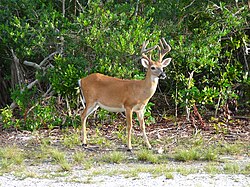The Key deer is a subspecies of white-tailed deer which migrated to the Florida Keys from the mainland over a land bridge during the Wisconsin glaciation. The earliest known written reference to Key deer comes from the writings of Hernando de Escalante Fontaneda, a Spanish sailor shipwrecked in the Florida Keys and captured by Native Americans in the 1550s.
Endangered status
Key deer were hunted as a food supply by native tribes, passing sailors, and early settlers. Hunting them was banned in 1939, but widespread poaching and habitat destruction caused the subspecies to plummet to near-extinction by the 1950s. The National Key Deer Refuge, a federally administered National Wildlife Refuge operated by the Wildlife Service, was established in 1957.
Recent population estimates put the population between 700 and 800, putting it on the list of endangered species. Road kills from drivers on US 1, which traverses the deer's small range, are also a major threat, averaging between 125 and 150 kills per year, 70% of the annual mortality.
The population has been affected by the fragmentation, destruction and degradation of its habitat, generally due to urbanization. Human feeding of deer has also proven problematic, as the animals become dependent on this food source. Fences have become an obstacle to migration and dispersal. [10]
However, the population has made an encouraging rise since 1955, when population estimates ranged as low as 25, and appears to have stabilized in recent years. Still, recent human encroachment into the fragile habitat and the deer's relatively low rate of reproduction point to an uncertain future for the subspecies. In August 2019 the USFWS recommended that the Key deer be "delisted due to recovery". [6] The species remained listed, but its recovery plan was amended in 2022 to specify the conditions in which delisting or downlisting would be appropriate. [11]
The ongoing rise in sea level, owing to climate change, is a new threat to its remaining habitat on the islands of southern Florida. [12] Beginning in 2023 when assisted migration was newly authorized as a recovery option for endangered species, Key deer was among the animal species mentioned in the press that might have no other option for escaping extinction in its historical range. [13] A November 2023 news article about the 50th anniversary of the Endangered Species Act summed up the problem for Key deer this way: "Rising seas created the Key deer. Rapidly rising seas, a symptom of human-caused climate change, are challenging its continued existence and raising tough questions for the people trying to keep the nation's more than 1,300 other threatened and endangered species alive." [14]
Screw worm infestation
In September 2016, a screw worm infestation was discovered (the first infestation of its kind in the U.S. since 1982) to be affecting the Key deer population, necessitating the euthanasia of affected animals. The screw worm is a fly larva that enters an open wound of a live animal and eats the flesh of the animal from within, leading to a gruesome death. The female fly mates once in her life, so the infestation can be battled by introducing sterile male flies to the population, causing the females to die out without laying fertile eggs. Other steps to battle the outbreak included injecting deer with antiparasitic drugs, fencing off healthy sections of the population, and tracking a portion of deer with radio collars. The pest was declared as eradicated in April 2017. The outbreak killed 135 deer, roughly an eighth of the herd. [15] [16] [17] [18]







